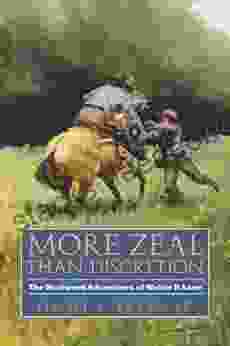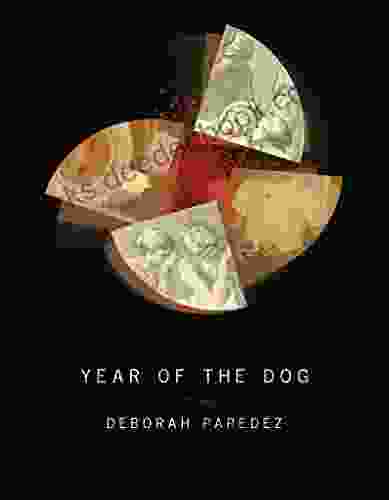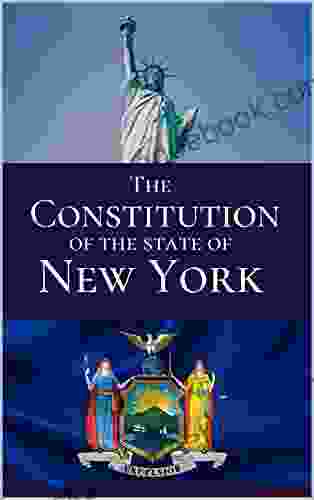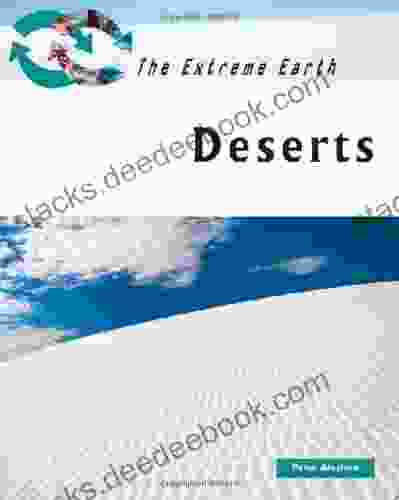Deserts: The Extreme Earth

Deserts are regions that receive very little rainfall, typically less than 250 millimeters (10 inches) per year. They are characterized by sparse vegetation, high temperatures, and low humidity. Deserts can be found on all continents except Antarctica, and they cover about one-third of the Earth's land surface.
4.1 out of 5
| Language | : | English |
| File size | : | 4961 KB |
| Text-to-Speech | : | Enabled |
| Screen Reader | : | Supported |
| Word Wise | : | Enabled |
| Print length | : | 178 pages |
Types of Deserts
There are two main types of deserts: hot deserts and cold deserts. Hot deserts are found in tropical and subtropical regions, and they are characterized by high temperatures and low humidity. Cold deserts are found in polar and subpolar regions, and they are characterized by low temperatures and low humidity.
Hot Deserts
Hot deserts are the most common type of desert. They are found in regions that receive very little rainfall, typically less than 250 millimeters (10 inches) per year. Hot deserts are characterized by high temperatures, low humidity, and sparse vegetation. The average temperature in a hot desert is typically between 20 and 30 degrees Celsius (68 and 86 degrees Fahrenheit). However, temperatures can reach as high as 50 degrees Celsius (122 degrees Fahrenheit) in the hottest deserts.
Hot deserts are found in all continents except Antarctica. The largest hot desert in the world is the Sahara Desert, which covers an area of over 9 million square kilometers (3.5 million square miles). Other major hot deserts include the Gobi Desert, the Arabian Desert, and the Atacama Desert.
Cold Deserts
Cold deserts are found in polar and subpolar regions. They are characterized by low temperatures and low humidity. The average temperature in a cold desert is typically between -10 and -20 degrees Celsius (14 and -4 degrees Fahrenheit). However, temperatures can reach as low as -50 degrees Celsius (-58 degrees Fahrenheit) in the coldest deserts.
Cold deserts are found in all continents except Antarctica. The largest cold desert in the world is the Antarctic Polar Desert, which covers an area of over 14 million square kilometers (5.4 million square miles). Other major cold deserts include the Arctic Polar Desert and the Tibetan Plateau.
Climate of Deserts
The climate of deserts is characterized by high temperatures, low humidity, and low rainfall. The average temperature in a desert is typically between 20 and 30 degrees Celsius (68 and 86 degrees Fahrenheit). However, temperatures can reach as high as 50 degrees Celsius (122 degrees Fahrenheit) in the hottest deserts and as low as -50 degrees Celsius (-58 degrees Fahrenheit) in the coldest deserts.
The humidity in deserts is typically very low, often below 20%. This is because the air in deserts is very dry and there is very little water vapor in the atmosphere. The low humidity in deserts can make it difficult to breathe and can cause skin and eye irritation.
The rainfall in deserts is typically very low, often less than 250 millimeters (10 inches) per year. This is because the air in deserts is very dry and there is very little water vapor in the atmosphere. The low rainfall in deserts can make it difficult for plants and animals to survive.
Geology of Deserts
The geology of deserts is characterized by the presence of sand, dunes, and other wind-blown deposits. The sand in deserts is typically composed of quartz, which is a very hard mineral. The dunes in deserts are formed by the wind, which picks up sand and carries it away. The dunes can be very large, and some can reach heights of over 100 meters (328 feet).
Other wind-blown deposits in deserts include loess, which is a fine-grained sediment that is composed of silt and clay. Loess is typically found in the valleys of deserts and can be very thick. It is a very fertile soil and is often used for agriculture.
Geography of Deserts
Deserts are found on all continents except Antarctica. The largest desert in the world is the Sahara Desert, which covers an area of over 9 million square kilometers (3.5 million square miles). Other major deserts include the Gobi Desert, the Arabian Desert, and the Atacama Desert.
Deserts are often located in the interior of continents, where they are far from the ocean. This is because the ocean provides moisture to the air, which can help to prevent the formation of deserts. Deserts are also often located in regions that are dominated by high pressure systems. High pressure systems prevent the formation of clouds and precipitation, which can lead to the development of deserts.
Vegetation of Deserts
The vegetation of deserts is sparse and adapted to the harsh conditions. The most common
4.1 out of 5
| Language | : | English |
| File size | : | 4961 KB |
| Text-to-Speech | : | Enabled |
| Screen Reader | : | Supported |
| Word Wise | : | Enabled |
| Print length | : | 178 pages |
Do you want to contribute by writing guest posts on this blog?
Please contact us and send us a resume of previous articles that you have written.
 Novel
Novel Page
Page Story
Story Reader
Reader Library
Library E-book
E-book Newspaper
Newspaper Paragraph
Paragraph Bookmark
Bookmark Shelf
Shelf Synopsis
Synopsis Tome
Tome Bestseller
Bestseller Classics
Classics Narrative
Narrative Biography
Biography Autobiography
Autobiography Memoir
Memoir Encyclopedia
Encyclopedia Dictionary
Dictionary Thesaurus
Thesaurus Character
Character Librarian
Librarian Card Catalog
Card Catalog Borrowing
Borrowing Study
Study Research
Research Scholarly
Scholarly Lending
Lending Reserve
Reserve Journals
Journals Reading Room
Reading Room Rare Books
Rare Books Special Collections
Special Collections Literacy
Literacy Study Group
Study Group Thesis
Thesis Dissertation
Dissertation Storytelling
Storytelling Awards
Awards Jeff Rasley
Jeff Rasley Lasean Smith
Lasean Smith Dennis Chong
Dennis Chong Julie Clark
Julie Clark Harvey Yoder
Harvey Yoder Kathryn A T Knox
Kathryn A T Knox Eli Boschetto
Eli Boschetto Elizabeth Keathley
Elizabeth Keathley Arnab Biswas
Arnab Biswas Alexander Pushkin
Alexander Pushkin Georgia Ivey Green
Georgia Ivey Green Michael Kimmage
Michael Kimmage Geraldine K Piorkowski
Geraldine K Piorkowski Sara Goodman Confino
Sara Goodman Confino Sonia Levitin
Sonia Levitin James J Wirtz
James J Wirtz Cynthia Dewi Oka
Cynthia Dewi Oka Cyrus Parsa
Cyrus Parsa Dan Yaccarino
Dan Yaccarino Melanie Simms
Melanie Simms
Light bulbAdvertise smarter! Our strategic ad space ensures maximum exposure. Reserve your spot today!

 Glen PowellThe Facilitator Fieldbook: A Comprehensive Guide to Designing, Implementing,...
Glen PowellThe Facilitator Fieldbook: A Comprehensive Guide to Designing, Implementing,... Heath PowellFollow ·9.7k
Heath PowellFollow ·9.7k Richard AdamsFollow ·10.3k
Richard AdamsFollow ·10.3k Kirk HayesFollow ·11.2k
Kirk HayesFollow ·11.2k Isaac AsimovFollow ·8.7k
Isaac AsimovFollow ·8.7k Jerome BlairFollow ·14.8k
Jerome BlairFollow ·14.8k George Bernard ShawFollow ·7.4k
George Bernard ShawFollow ·7.4k Emilio CoxFollow ·17.1k
Emilio CoxFollow ·17.1k Jim CoxFollow ·17.6k
Jim CoxFollow ·17.6k

 Amir Simmons
Amir SimmonsMore Zeal Than Discretion: A Closer Look at the Risks and...
Enthusiasm is often seen as a positive...

 Wayne Carter
Wayne CarterYear of the Dog: American Poets Continuum 178
Year of the Dog is a...

 David Foster Wallace
David Foster WallaceThe Constitution of the State of New York: A...
The Constitution of the...

 Harvey Bell
Harvey BellSmall Cetaceans of Japan: Exploitation and Biology
Small cetaceans, including...

 Blake Bell
Blake BellEffortless Elegance: A Comprehensive Guide to Captivating...
In the realm of crocheting,...
4.1 out of 5
| Language | : | English |
| File size | : | 4961 KB |
| Text-to-Speech | : | Enabled |
| Screen Reader | : | Supported |
| Word Wise | : | Enabled |
| Print length | : | 178 pages |












